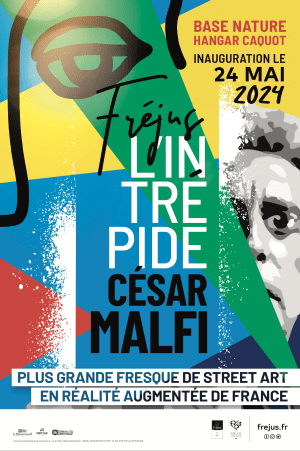Description
Warm and contemporary, the Notre Dame de Jérusalem chapel otherwise known as Chapelle Cocteau is among the range of eclectic monuments around the heart of the city.
There are sensual curves drawn by Cocteau, dancing and hugging the rhythm of sunbeams tinged with stained glass. Between the drawings of a poet soon swept away by disease and the works of the artists who succeed him, visitors can explore a world peopled with naive and delicate looking holy characters.
Ticket office
Share
Favourite
- It is Cocteau's last spiritual work
- Large wooded park
- The nuances of the colours in the mosaic floor
Practical info
Opening times
From 1 October to 31 March
From Tuesday to Saturday
09:30 am – midday / 2:00 pm -4:30 pm
Closed Sunday, Monday and public holidays
Prices
Full price: €6
Reduced rate: €5
Group rate (minimum 20 people): €5
School group: €20
Prices
Admission only: €3 (individual ticket, valid for one day)
Fréjus Pass: €6 (Fréjus Individual Pass 4 sites, valid for 7 days). From 18 years old.
Frejus Reduced Pass: €4 (Fréjus Pass Individual 4 sites, valid 7 days). Children from 12 to 17 years old, students under 25 years old (on presentation of the card), group of more than 10 people, jobseekers (on presentation of proof), school classes and schools outside Fréjus / Saint-Raphaël.
Fréjus Integral Pass: Individual Pass 4 sites* and cloister of the cathedral, valid for 7 days. The Integral Pass does not exist with a reduced rate.
Free: Children under 12, people with disabilities (on presentation of proof), guides approved by the Ministry of Culture and Communication (with a professional card), curators of the territorial heritage or the State, journalists (with a professional card), school groups within the framework of the Artistic and Cultural Education Convention and their accompaniers and teachers in Fréjus within the framework of preparing visits with the prior approval of the Head of Architecture and Heritage.
Free of charge
Under 18 (family and not school groups)
18-25 years old (European Union nationals and non-European legal residents in the territory of the European Union)
People with disabilities and a companion
Jobseekers, on presentation of a certificate dated less than 6 months previously
Culture card – ICOM card
Chapelle Cocteau: history
Abandoned for several years, the city of Fréjus acquired the chapel and restored it in 1989; it was listed as a Historic Monument on 20 January of the same year.
At the end of the summer of 1962, Cocteau yielded to the Vatican’s request to build a sanctuary for the order of the Holy Sepulchre in Fréjus.
The order of the Holy Sepulchre of Jerusalem is a religious order created by Godefroy de Bouillon after the capture of Jerusalem in 1099. This order serves to protect the Holy Sepulchre but also the liturgical life of the sanctuary and, subsequently, the entire Frankish kingdom of Jerusalem. In 1489, Innocent VIII decided on the suppression of the canonical order and incorporated into the order of Saint John of Jerusalem. Since 1868, there exists the equestrian order of the Holy Sepulchre of Jerusalem.
The desire of Nice banker Mr Martinon, the project for the chapel in the district of Tour de Mare in Fréjus was designed with the architect Jean Triquenot, who was inspired by the tomb of Christ, the Santa-Fosca church on the island of Torcello in Venice, and the Pantheon in Rome (a direct quote from Jean Triquenot).
The first stone was laid on 24 February 1963. After the death of Jean Cocteau, Edouard Dermit finished the work in 1965. The stained glass windows were by Raymond Moretti, a painter from Nice and the ceramics by Raymond Pelissier from Fréjus. The outdoor mosaics were executed in 1992 by Laetitia Léotard and Henri Virmouneix.
The Chapelle de Fréjus is one of Jean Cocteau’s last works, along with the stained-glass windows on Saint-Maximin church in Metz, completed in the late 1960s.
The iconographic theme inside is essentially based on the “Passion of Christ” and the crusades. The Passion of Christ is the series of events that preceded and accompanied the death of Jesus. It includes the Last Supper, the Crucifixion, the Arrest of Christ, the Virgin with the Seven Sorrows, the Resurrection, and the Angel of the Apocalypse and the hieratic characters who chant around Christ.
But there are also a number of references to the Knights of the Crusades, Knights of the Temple, the Holy Sepulchre and the war cry of the Crusaders “God wills it”.
Some biographical information about the artist:
Jean Cocteau was born on 5 July, 1889 in Maison-Laffite and died on 11 October 1963 in his home in Milly-la-Forêt. First drama in his life occurred when his father committed suicide on 5 April 1898 – Cocteau was 9 years old. At the age of 15, he was a student at Condorcet High School, but showed little interest in studying. He was expelled from school for indiscipline in 1904 and failed his baccalaureate twice.
Inspirer of surrealism, working with the Dada movement, he had a great influence on the work of others along with Erik Satie, a contemporary French composer. Poet, graphic designer, draftsman, playwright and filmmaker, he was elected to the Académie Française in 1955, chair No. 31. He was also a novelist, painter, lithographer, ceramist, upholsterer…
Reformed in 1914, he participated in the war as a paramedic.
The sudden death of his friend Radiguet in 1923, with whom he shared a penchant for opium, took him to Villefranche-sur-mer and the Hotel Welcome.
Another tragedy occurred in 1930, during his affair with Nathalie Paley. She was probably pregnant by the poet, a pregnancy that did not go to term. Whether it was an abortion or the effect of opium, will never be known.
Cocteau then had relationships with two actors, Jean Marais and Edouard Dermit, the latter was officially adopted by Cocteau and was behind the success of Edith Piaf. In fact, in 1940, the play, “Le Bel Indifférent” written for Edith Piaf was a great success. Among the immense successes that went down in posterity was “La Belle et la Bête” (1946).
He chaired the Cannes festival jury in 1953 and 1954.
Playing an ambiguous role during the Second World War, he above all demonstrated a certain pacifism and then committed himself to defending the right to conscientious objection.
In the spring of 1950 he was invited to Villa Santo Sospir in Saint Cap Ferrat, Francine Weisweller’s villa, which encouraged by Matisse he decorated. He liked the house so much that he went back for eleven years. In 1960, he filmed the “Testament d’Orphée” with the financial support of François Truffaut.
He died on the same day as Edith Piaf, at the age of 74. He is buried in the Saint-Blaise-des-Simples chapel in Milly-la-forêt. Shortly before his death he wrote: “Of course I believe. Of course I pray, but there can be no question of your god “and the epitaph on his grave says:”I stay with you”.
Édouard Dermit, who produced the drawings in the chapel after the death of the artist, (120 sketches were made by Jean Cocteau for this chapel), joined him in the same vault in 1995.






